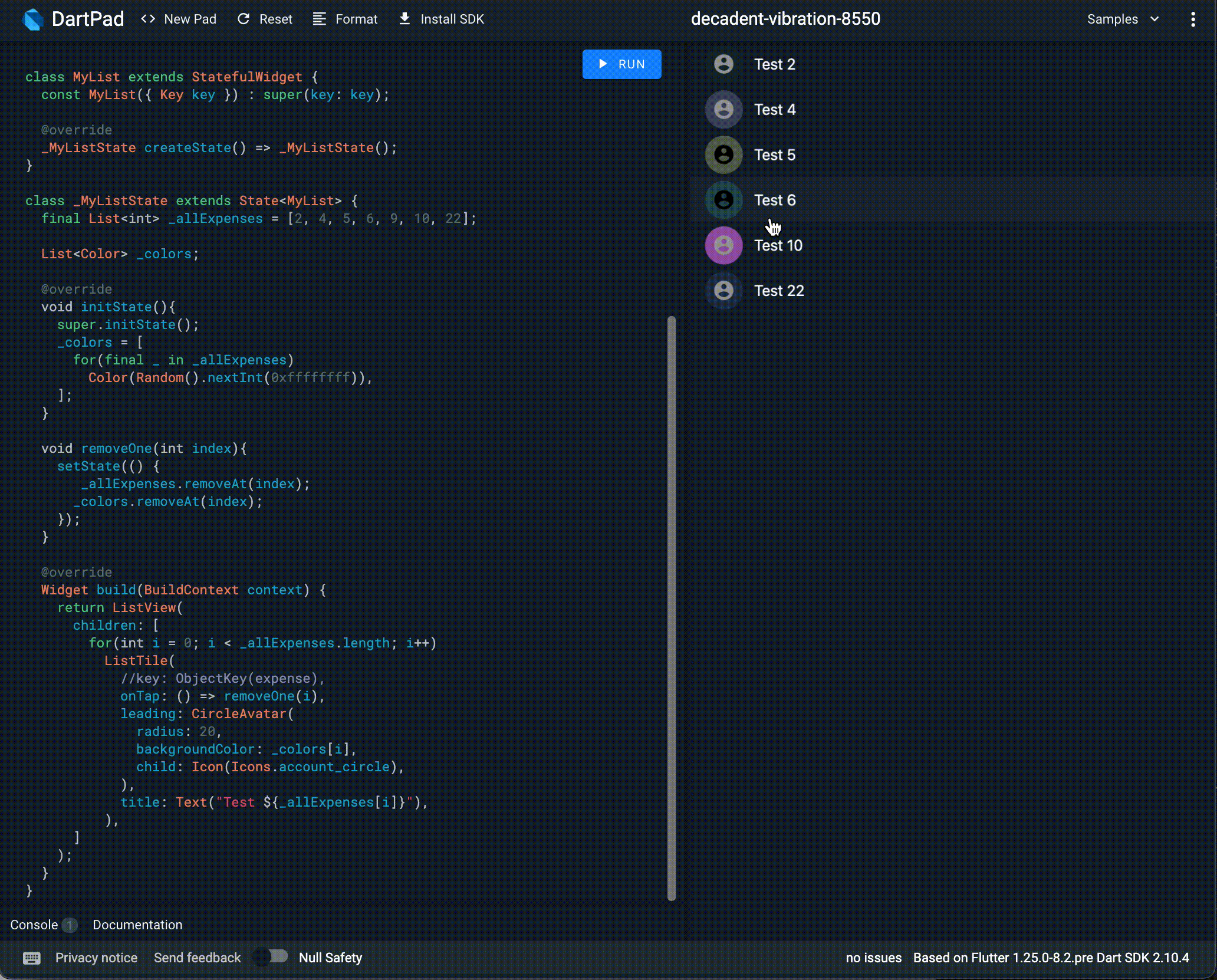Color state is changing when I am deleting item from list and do setState((){})
I am assigning random color to a ListTile leading property in flutter, but when I am deleting a item using setState, color of all list items are changing, I tried to use ObjectKey() , I want to keep the color state constant
ListTile(
key: ObjectKey(expense),
onTap: () {
setState(() {
_allExpenses.remove(expense);
});
},
leading: CircleAvatar(
radius: 20,
backgroundColor: Color(Random().nextInt(0xffffffff)),
child: FindIcon(expense.type),
),
title: Text("Test"),
)
I am using provider and notifyListeners(); which make rebuild of the UI on every item delete
2 Answers
You should call Random() in the initState so that its not called again when you do a setState.
Color bgColor;
@override
void initState(){
super.initState()
bgColor = Color(Random().nextInt(0xffffffff));
}
and your ListTile
ListTile(
key: ObjectKey(expense),
onTap: () {
setState(() {
_allExpenses.remove(expense);
});
},
leading: CircleAvatar(
radius: 20,
backgroundColor: bgColor,
child: FindIcon(expense.type),
),
title: Text("Test"),
)
In your case, the setState will rebuild every time. If you want to work with keys, a new wrapper of ListTile must be created.
But, there is another alternative. In the initState, a list of random colors can be created:
class MyList extends StatefulWidget {
const MyList({ Key key }) : super(key: key);
@override
_MyListState createState() => _MyListState();
}
class _MyListState extends State<MyList> {
final List<int> _allExpenses = [2, 4, 5, 6, 9, 10, 22];
List<Color> _colors;
@override
void initState(){
super.initState();
_colors = [
for(final _ in _allExpenses)
Color(Random().nextInt(0xffffffff)),
];
}
void removeOne(int index){
setState(() {
_allExpenses.removeAt(index);
_colors.removeAt(index);
});
}
@override
Widget build(BuildContext context) {
return ListView(
children: [
for(int i = 0; i < _allExpenses.length; i++)
ListTile(
//key: ObjectKey(expense),
onTap: () => removeOne(i),
leading: CircleAvatar(
radius: 20,
backgroundColor: _colors[i],
child: Icon(Icons.account_circle),
),
title: Text("Test ${_allExpenses[i]}"),
),
]
);
}
}
That is a good alternative because you can control the needed memory for those random colors. That logic can be extended to ChangeNotifiers with their notifyListeners() using the addListener() in the initState:
@override initState(){
...
myChangeNotifierList.addListener(() => setState((){}));
}
There is another alternative where you delegate the responsibility of handling the random color and keeping the state of each list tile.
class MyListWithKeys extends StatefulWidget {
const MyListWithKeys({ Key key }): super(key: key);
@override
_MyListWithKeysState createState() => _MyListWithKeysState();
}
class _MyListWithKeysState extends State<MyListWithKeys> {
final List<int> _allExpenses = [2, 4, 5, 6, 9, 10, 22];
void removeOne(int expense){
setState(() {
_allExpenses.remove(expense);
});
}
@override
Widget build(BuildContext context) {
return ListView(
children: [
for(final expense in _allExpenses)
MyTile(
key: ObjectKey(expense),
expense: expense,
onTap: () => removeOne(expense),
),
]
);
}
}
class MyTile extends StatefulWidget {
const MyTile({
Key key,
@required this.expense,
@required this.onTap,
}) : assert(expense != null),
assert(onTap != null),
super(key: key);
final int expense;
final VoidCallback onTap;
@override
_MyTileState createState() => _MyTileState();
}
class _MyTileState extends State<MyTile> {
Color _color;
@override
void initState() {
super.initState();
_color = Color(Random().nextInt(0xffffffff));
}
@override
Widget build(BuildContext context) {
return ListTile(
onTap: widget.onTap,
leading: CircleAvatar(
radius: 20,
backgroundColor: _color,
child: Icon(Icons.account_circle),
),
title: Text('Test ${widget.expense}'),
);
}
}
User contributions licensed under CC BY-SA 3.0
